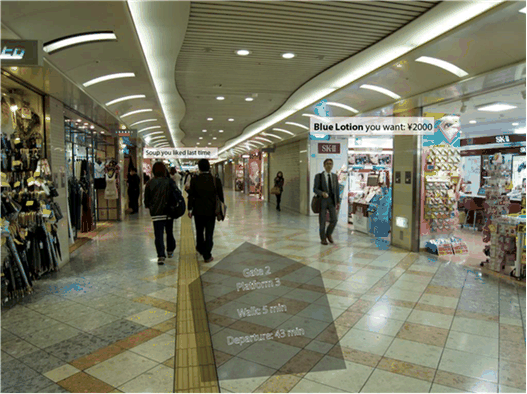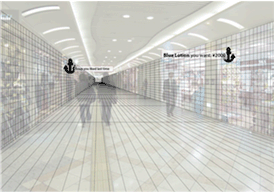Content for TR 22.856 Word version: 19.2.0
1…
5…
5.2…
5.3…
5.4…
5.5…
5.6…
5.7…
5.8…
5.9…
5.10…
5.11…
5.12…
5.13…
5.14…
5.15…
5.16…
5.17…
5.18…
5.19…
5.20…
5.21…
5.22…
5.23…
5.24…
5.25…
5.26…
5.27…
5.28…
6
7…
7.2
8
A
B
C…
5 Use Cases
5.1 Use Case on Localized Mobile Metaverse Service
5.1.1 Description
5.1.2 Pre-conditions
5.1.3 Service Flows
5.1.4 Post-conditions
5.1.5 Existing feature partially or fully covering use case functionality
5.1.6 Potential New Requirements
...
...
5 Use Cases p. 14
5.1 Use Case on Localized Mobile Metaverse Service p. 14
5.1.1 Description p. 14
This use case will consider the potential service opportunities that arise when advanced location information is available to trigger AR based services.
A precursor to this use case is briefly considered: i-mode service, introduced by NTT DOCOMO in 1999. The discussion of i-mode serves as an inspiration. This service was extremely successful, was one of the early mobile services beyond messaging and voice, and has many potential similarities with metaverse services. This service in many ways preceded and foresaw mobile internet services that would arise 10 years later. Users could access data on-line concerning weather, traffic, etc. While there were many revolutionary aspects to i-mode, three are particularly relevant for this use case:
- i-area - a location information service that enabled the user to identify locally relevant information - concerning traffic, maps and retail store information for business in the user's proximity.
- i-channel - a distribution service of 'latest information' that the user could further investigate (through interaction) and whose display was user configurable.
- a fully decentralized content and service creation framework allowing third parties to easily provide content, especially relevant: location specific content. This made it possible for small businesses to provide information to potential customers in the proximity such as opening hours, special offers, etc. It was even possible for those in the same location to meet and join 'virtually,' e.g. to play a computer game with other passengers in the same train car or bus.

Figure 5.1.1-1: Localized Mobile Metaverse Services offering relevant information
(⇒ copy of original 3GPP image)
(⇒ copy of original 3GPP image)
Here, the AR annotation provides much more than an augmented map. The user is going to catch a train. (a) The path to the platform is shown without obstructing the user's perception of their proximity, where the contrast is good and no distractions appear. The (b) store on the right can provide content that may be relevant to the potential shopper, here the store's opening hours. Further along, (c) a restaurant provides a personalized message, reminding the user that they ate there in the past and ordered soup. These services are linked to the space that the user is in. See Figure 5.1.1-2, below.

Figure 5.1.1-2: Services offering relevant information are anchored in space
(⇒ copy of original 3GPP image)
(⇒ copy of original 3GPP image)
The three information augmentations that are displayed are the result of different source of information. The path information (a) can be presented anywhere that it fits into the scene, where the information for (b) and (c) are anchored in space. The information depends on interaction between the user (or the user's preferences, application context, etc.): the content shown depends on the user's interest: (a) they are travelling, and the navigation app knows what information the user needs to see. (b) The user has sought Blue Lotion and it is available here - the user's 'persistent search' shows local results. (c) At this time of day, the user often eats, so the restaurant on the left's reminder is welcome.
The 5G system enables this 'access to local services' in a number of ways.
5.1.2 Pre-conditions p. 16
Ulysses uses his AR capable glasses while travelling. These are tethered to a UE that he carries. This UE receives 5G service from the mobile network operator he has a subscription with, M. Ulysses is interested in using his AR capable glasses to receive relevant information, so he has selected which applications are 'relevant.' These applications are therefore configured with the operator M to be 'active.' The purpose of this configuration will be described below.
Local services, that is services that are localized, have anchors that can be relevant to applications. A pre-condition of this use case is that such services exist and have spatially defined access. This is considered in this use case as an 'anchor.' The local service provider associates a service with an anchor, potentially as well as metadata concerning the service (e.g. 'is a restaurant'.) This information is available to M, either because the local services have been registered with M directly, or are available in maps, registries, or other information sources that M has access to (e.g. information that is provided by the UE).
5.1.3 Service Flows p. 16
Ulysses transfers at the Osaka train station. He has some time before he catches his connecting train. As he is hungry, he activates a 'persistent search' on his mobile device to inform him of opportunities to eat as he traverses the station. His mobile device begins to collect information about his surroundings. The collected information can include information that is obtained by interacting with nearby devices (e.g. sensors and other mobile devices). He also has a shopping list (a set of items of interest) from retail stores. He makes use of a navigation facility so that he will neither lose his way nor lose track of time.
This has the following consequences:
- As a result of the applications activated by the user, and the user's preferences, the UE requests the 'localized mobile metaverse' service enabler offered by M, providing a list of 'persistent search' information and the information that was collected from the user's surroundings.
- M receiving the persistent search and the information that was collected from the user's surroundings, engages localized service activation. The location of the UE is compared against the search criteria, the information that was collected from the user's surroundings and information available to M of spatially defined access points.
- M identifies a match - essentially a 'JOIN' of user preferences / application persistent search criteria "restaurants" AND location (in the user's field of view) AND local spatially defined access exists.
-
This match is provided to the UE, for further processing by the application.
Example 1:
The application [service] associated with 'restaurants' has stored information the user has eaten there and indicated it was 'good.' Thus the annotation 'Soup you liked last time' is displayed.Example 2:The application [service] associated with 'shopping' has stored a shopping list. When a local 'shopping service access point' has been identified, the shopping application queries the service provider directly. If there is success, the result is displayed. Here: "Blue Lotion you want ¥2000."
- The UE is able to interact with the application to obtain information associated with the service.
5.1.4 Post-conditions p. 16
Spatial information has successfully been employed to allow a user to identify services. Please see 5.5 for further information on how spatial information is obtained.
The user's location has been applied.
The information output of different applications are integrated into the media that the user sees through the AR display device. The information associated with the services is displayed in the proper location in the user's field of view.
Ulysses may choose to eat soup or buy Blue Lotion.
M may charge Ulysses for this service, e.g. for the use of a persistent search and for each successful result provided.
5.1.5 Existing feature partially or fully covering use case functionality p. 17
Location based services exist, to identify the position of the UE.
The 5GS supports means to expose the UE's location to a 3rd party service provider.
Location Services for CIoT in clause 4.5.19 of TS 23.682, allow an LCS client to obtain the location of a CIoT UE location, either periodically or in a triggered manner, as well as the last known location of a UE that is unreachable for an extended time.
Location services, as specified in clause 5.5 of TS 23.273 support exposure to authorized third parties through a CAPIF API between NEF and the AF. The information that can be exposed includes the target UE identity and parameters for location events, e.g. the trigger (the UE enters, leaves or is within a target area), the time between reports if multiple reports are requested, and of course the precise location in three dimensions up to the maximum horizontal and vertical accuracy supported.
Effectively, there are also numerous 'over the top' mechanisms that essentially communicate GPS or other location information that can be accessed by the application from the mobile OS and terminal equipment. The client application on the UE supplies this location information to an AS 'opaque' to the 5G system (that is, in application traffic that is not visible to the 5G system.) In this sense, the 5G system supports location services in that it provides a UE with the mobile broadband services.
Using the location information obtained by any of these three mechanisms described above, a service provider can identify appropriate content for or interaction with the user, by means that are out of scope of 3GPP. This could include the services introduced in clause 5.1.1 in the example of i-mode. The application service can be configured or used in such a way that the user's interest is known, and location-relevant information can be 'pushed' to the client application.
There is a significant gap between this support and the functionality described in this use case. The Localized Mobile Metaverse Services unlike e.g. i-mode and similar location service enabled applications does not assume the use of a specific mediating application that organizes and delivers information. Rather, this use case features and motivates a service enabler that allows the user to discover different locally relevant services and content, so that any available application service can be accessed by the UE, e.g. through a web browser or other interactive-media capable general purpose application.
5.1.6 Potential New Requirements p. 17
[PR 5.1.6-1]
The 5G system shall enable third parties to make known the availability of application services (i.e. provided by Application Servers) associated with a precise location.
[PR 5.1.6-2]
The 5G system shall provide suitable exposure mechanisms for application services (i.e. provided by Application Servers) associated with a precise location available in the user's proximity (e.g. within line of sight), such that the mobile metaverse services can conform to specific service constraints.
[PR 5.1.6-3]
The 5G system shall provide suitable means to discover mobile metaverse services (i.e. provided by mobile metaverse servers) associated with a precise location available in the user's proximity.
[PR 5.1.6-4]
The 5G system shall enable the rendering of diverse media, from one or more mobile metaverse services associated with a single location, to be combined to form a single location related service experience.